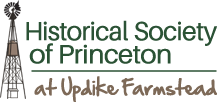Albert E. Hinds was born in Princeton, New Jersey on April 14, 1902. He and his siblings attended the Princeton segregated school, Witherspoon School for Colored Children, and he continued his education at Talladega College in Talladega, Alabama. Mr. Hinds’ services to the Princeton community were numerous. In 1925, he along with another resident of Princeton, reopened the Colored YMCA that had been closed for a number of years. He served as the Y’s physical director and in 1933 was the playground director for both Hightstown and Princeton. Another notable accomplishment was helping to pave Nassau Street, transforming it from a simple dirt road to a major thoroughfare.
Over the years Mr. Hinds was a member of the Zoning Board, a trustee of the Mt. Pisgah AME Church, and on the advisory board of the Historical Society of Princeton. An invaluable member of the community, Mr. Hinds passed away in Princeton at the age of 104.
Click here to read Shirley Satterfield’s moving tribute to Mr. Hinds. In 2005, the Town Topics featured an article on Albert Hinds’ fascinating life in Princeton, which is available here: Article on Hinds


Albert E. Hinds Gates

The Albert E. Hinds Gates in Princeton’s Hinds Plaza were dedicated on September 29, 2013. Princeton resident Eric Broadway gave a tribute to Albert Hinds at the dedication ceremony; click here for the text of his speech.
On July 16, 2013, The Princeton Packet featured an article by Pam Hersh on the Hinds Gates project. The article, reproduced with permission of The Princeton Packet, is available here: Article on Hinds Gates.
On April 24, 2007, Princeton Borough’s Mayor and Council honored Albert E. Hinds’ life and his 90 years of service to the Princeton community by naming the popular plaza on Witherspoon Street the Albert E. Hinds Community Plaza. The decision was informed by the tributes of Shirley Satterfield, Jim Floyd, and other citizens who shared their stories of Mr. Hinds as a mentor, historian, trailblazer, and friend to all during his long life.
Community leaders including Wendy Benchley, Judith K. Brodsky, Leslie Burger, James Floyd, Jeff Nathanson, Shirley Satterfield, Kate Somers, Susan Taylor, and Barbara Trelstad formed the Hinds Plaza Art Committee to oversee the creation of a piece of public art for the plaza to commemorate Mr. Hinds’ role in bringing the Princeton community together. They selected artist Tom Nussbaum of Montclair, New Jersey, to create sculptural gates incised with patterns from traditional American quilts. The patterns reflect a mix of ethnic influences and symbolize a diverse community coming together. The design also incorporates allusions to Mr. Hinds’ life. For more information on the artist, please see: http://www.tomnussbaum.com.
Artist Tom Nussbaum describes the Hinds Gates as follows: “This artwork honors the memory of Mr. Hinds in gateways to the plaza that feature his words: ‘It’s always the right time to do the right thing’. These words, which paraphrase Dr. Martin Luther King Jr., were one of Mr. Hinds’ favorite sayings. They embody Mr. Hinds’ outlook on life, and serve to remind us that it was Mr. Hinds’ positive perspective that touched so many in the Princeton community. Surrounding these words is a decorative motif using patterns from traditional American quilts, that can be traced back to sources from the American, European, and African continents. The patterns are used here to symbolize a diverse community together, something that Mr. Hinds was helping to accomplish through his activities in his hometown of Princeton. Located at the two main entrances to the plaza, these permanently open gateways and the accompanying plaques and website, celebrate the role of Mr. Hinds and the history of the Jackson – Witherspoon neighborhood in the Princeton Community.”
| The Albert E. Hinds Gates | |
|---|---|
 |
 |
| Quilt Patterns Featured in the Gates | |
|---|---|
 |
 |
| Pattern name: Church Window. Albert Hinds was a lifelong member of the Mount Pisgah Church on Witherspoon Street in Princeton. He served as a church trustee and was deeply involved in church activities. | Pattern name: Magnolia. After settling in Princeton, Albert Hinds’ maternal grandfather, Robert Elisha Hall, worked as a custodian at the Methodist Church, as well as on the campus of Princeton University. He spoke fondly of Dr. McCosh, President of the University from 1868-1888, whom he helped plant the large magnolia tree on the campus facing Nassau Street. |
 |
 |
| Pattern name: New Jersey. Albert Hinds was witness to a century of struggle and progress in the civil rights movement in New Jersey. | Pattern name: North Star. Albert Hinds maternal grandfather, Robert Elisha Hall, was born in 1850 and was a slave on a plantation near Wilmington North Carolina. At the close of the civil war, he came north to New Jersey after befriending a Union soldier. |
 |
 |
| Pattern name: Monkey Wrench. This quilt pattern, was found in a quilt from the 1920’s that was made by Rosa Whiting. The quilt was included in the 1996 exhibit “A Community Remembers- African American Life in Princeton.” | Pattern name: Hubcap. Albert Hinds’ first driving experience was around 1914 when he drove a hack (a horse drawn taxi) picking up passengers from the Princeton Junction train station. He continued to drive until 2004, at the age of 102. This pattern is from the hubcap of his last car, a 1988 Mercury Sable. |
